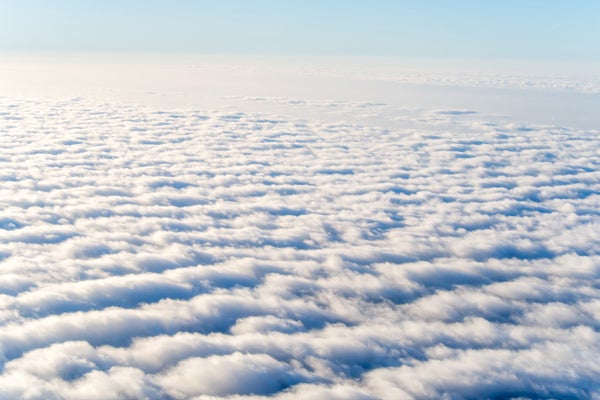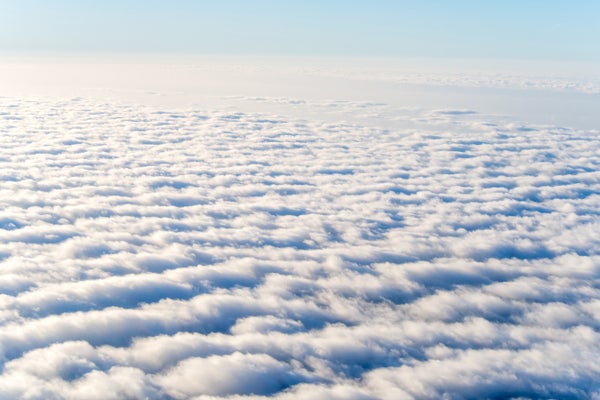
[ad_1]
Geoengineering Test Quietly Launches Salt Crystals into Atmosphere
A solar geoengineering experiment in San Francisco could lead to brighter clouds that reflect sunlight. The risks are numerous

An aerial view of a layer of stratocumulus clouds.
CLIMATEWIRE | The nation’s first outdoor test to limit global warming by increasing cloud cover launched Tuesday from the deck of a decommissioned aircraft carrier in the San Francisco Bay.
The experiment, which organizers didn’t widely announce to avoid public backlash, marks the acceleration of a contentious field of research known as solar radiation modification. The concept involves shooting substances such as aerosols into the sky to reflect sunlight away from the Earth.
The move led by researchers at the University of Washington has renewed questions about how to effectively and ethically study promising climate technologies that could also harm communities and ecosystems in unexpected ways. The experiment is spraying microscopic salt particles into the air, and the secrecy surrounding its timing caught even some experts off guard.
On supporting science journalism
If you’re enjoying this article, consider supporting our award-winning journalism by subscribing. By purchasing a subscription you are helping to ensure the future of impactful stories about the discoveries and ideas shaping our world today.
“Since this experiment was kept under wraps until the test started, we are eager to see how public engagement is being planned and who will be involved,” said Shuchi Talati, the executive director of the Alliance for Just Deliberation on Solar Geoengineering, a nonprofit that seeks to include developing countries in decisions about solar modification, also known as geoengineering.
“While it complies with all current regulatory requirements, there is a clear need to reexamine what a strong regulatory framework must look like in a world where [solar radiation modification] experimentation is happening,” she added.
The Coastal Atmospheric Aerosol Research and Engagement, or CAARE, project is using specially built sprayers to shoot trillions of sea salt particles into the sky in an effort to increase the density — and reflective capacity — of marine clouds. The experiment is taking place, when conditions permit, atop the USS Hornet Sea, Air & Space Museum in Alameda, California, and will run through the end of May, according to a weather modification form the team filed with federal regulators.
The project comes as global heat continues to obliterate monthly and yearly temperature records and amid growing interest in solar radiation modification from Silicon Valley funders and some environmental groups. It also follows the termination of a Harvard University experiment last month that planned to inject reflective aerosols into the stratosphere near Sweden before it was canceled after encountering opposition from Indigenous groups.
Solar radiation modification is controversial because widespread use of technologies like marine cloud brightening could alter weather patterns in unclear ways and potentially limit the productivity of fisheries and farms. It also wouldn’t address the main cause of climate change — the use of fossil fuels — and could lead to a catastrophic spike in global temperatures if major geoengineering activities were discontinued before greenhouse gases decrease to manageable levels.
The University of Washington and SilverLining, a geoengineering research advocacy group involved in the CAARE project, declined interview requests. The mayor of Alameda, where the experiment is being conducted, didn’t respond to emailed questions about the project.
The secrecy surrounding the landmark experiment seems to have been by design, according to The New York Times, which, along with a local newspaper, was granted exclusive access to cover the initial firing of the spray cannons.
“The idea of interfering with nature is so contentious, organizers of Tuesday’s test kept the details tightly held, concerned that critics would try to stop them,” the Times reported. The White House also distanced itself from the experiment, which is being conducted with the cooperation of a Smithsonian-affiliated museum.
The project team has touted its transparency, noting that visitors to the USS Hornet, which now serves as a floating museum, will be able to view the experiment.
“The world needs to rapidly advance its understanding of the effects of aerosol particles on climate,” Kelly Wanser, the executive director of SilverLining, said in a press release. “With a deep commitment to open science and a culture of humility, the University of Washington has developed an approach that integrates science with societal engagement, and can help society in essential steps toward advancing science, developing regulations, promoting equitable and effective decision-making, and building shared understanding in these areas.”
The CAARE project is part of a larger coastal study that the University of Washington consortium is planning to pursue. The second phase of that effort would take place on a pier around a mile offshore in a coastal environment, according to a study description the school released Monday.
While a peer review of that proposal was generally positive, the scientists also flagged some transparency shortcomings.
“One reviewer noted that it would help to have more information on the site location,” said a Washington-University-commissioned report. “Is there local resistance or concerns (whether founded or unfounded) around issues like local air quality, etc.? How many options exist, and how do different options affect the field study plan?”
The study plan also made no mention of its potential ecological impacts, a key consideration recommended by a 2022 Biden administration marine cloud brightening workshop. That’s a significant oversight, according to Greg Goldsmith, the associate dean for research and development at Chapman University.
“History has shown us that when we insert ourselves into modification of nature, there are always very serious unintended consequences,” said Goldsmith, who studies the implications of climate change for plant structure and function. “And therefore, it would be prudent to listen to what history has shown and look for consequences.”
Reprinted from E&E News with permission from POLITICO, LLC. Copyright 2024. E&E News provides essential news for energy and environment professionals.
[ad_2]